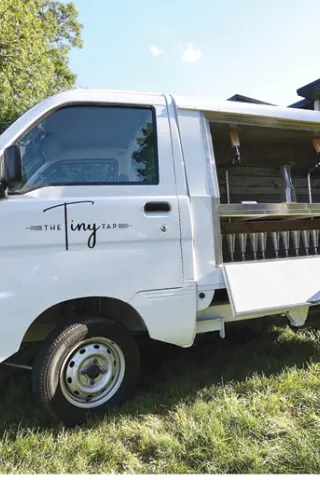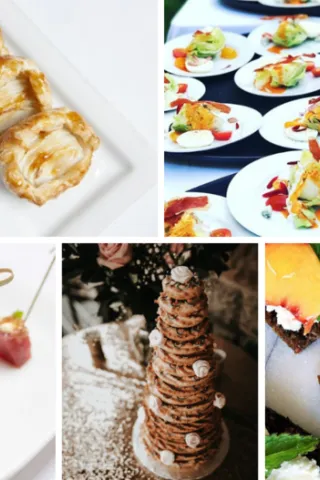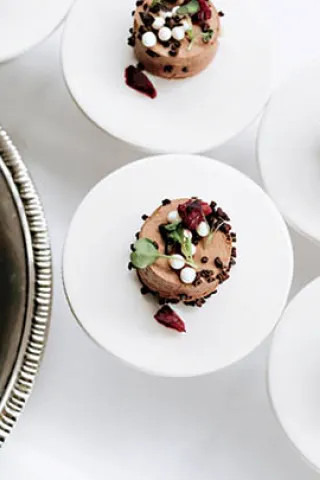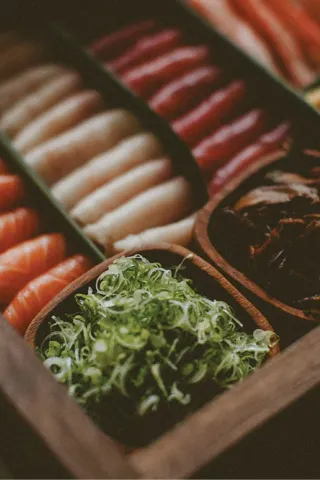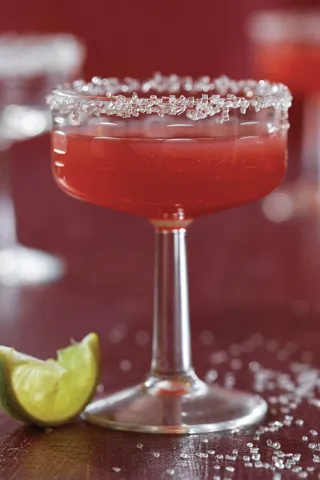By the time a wedding meal is served, the ceremony is already history, yet how the food is presented—as a plated meal, buffet, food stations, or passed hors d’oeuvres—truly sets the tone for the entire event. Will guests be served or will they mingle? Will service take place at a standard mealtime or would lighter fare be appropriate? Will food presentation become part of the entertainment itself or serve as a backdrop for memorable toasts and live music?
Making a decision that carries such weight need not be overwhelming. Kelly Schroeder, a wedding planner at Wildside Caterers, starts by asking couples about their vision. As they reflect on their personal style and expectations for the day, the right choice usually becomes apparent.
Julie Hamiel, one of Schroeder’s clients, didn’t take long to arrive at her decision for her October 2009 wedding: a plated meal at 317 on Rice Park, one of Wildside’s exclusive St. Paul venues. She had a vision of a “New-York-style wedding”—a sophisticated affair in a picturesque setting overlooking Rice Park, with dinner served late and live jazz to follow. Having her 135 guests sit down for formal service felt like a natural fit. “I looked at it as inviting who I wanted to take out to dinner that night. I wanted everything to be individually plated and taste like a chef produced it,” she says.
For a less-traditional second marriage and reception at a Unitarian church in Minneapolis, bride Robin King Cooper thought most about how the evening would flow. She wanted to avoid the formality of seating everyone at once with organized toasts, and instead let her guests focus on dancing and socializing. Food stations fit the bill. “Food stations allow for a lot more interaction between guests and more movement,” says Linda Savage of Class Act Catering, which handled the event. Cooper went for customizable, all-vegetarian options, like a quesadilla station where guests could choose their own fillings, and a dessert station in lieu of a formal wedding cake.
Sometimes the venue choice points to a clear-cut option. Lynn Guggemos of We Cater To You has done a number of weddings in backyards, public parks, and mansions; in all cases, she must first assess what the space can accommodate before any service decisions are made. “I always go to the facility with the client so we can walk through and consult with them on the set-up. Weather considerations, the space allotted for tables and chairs, where the food preparation will take place … all of that comes into play,” she says.
Tracie Kunz chose Towne Lakes Park in Albertville for her August 2009 wedding, catered by Guggemos. She loved the idea of a fun, creative ambiance that put her guests at ease. She chose a buffet-style meal featuring summery foods like shish kebabs grilled on-site and asparagus couscous salad, because it was best suited to her venue and let her guests, some of whom were vegetarians, experience many flavors.
While most couples have some cost limits in mind, there’s no catering consensus on which service option is the least expensive, so couples should first consider their ideal menu, then price it to see it fits their budget. Buffets can cut back on service staff, but, for example, Schroeder says the buffet option is slightly more expensive at Wildside, because guests can take as much as they want, with multiple meat selections, pushing up food costs. According to Guggemos, food selection can count for a lot when it comes to budget. “Depending on your choices, you can make a buffet feel more upscale or keep a plated meal within your price range,” she says.
Presumed low-budget options, like cocktail receptions and casual backyard gatherings, can be less economical than couples anticipate. Linda Adam of D’Amico Catering notes that passed hors d’oeuvres can be delicate and labor intensive, which adds to the cost; Guggemos says that rented items like tables, chairs, and a tent can drive up the price of a backyard soirée.
Budget isn’t the only practical consideration when you’re choosing a service style. Plated meals usually mean keeping track of entrée choices and creating a seating chart, which makes the planning process more rigorous, says Robyn Hellekson of Mintáhoe Catering. She also points out that plated meals will restrict the number of food choices, while buffets, food stations, and passed hors d’oeuvres can more readily accommodate vegetarian and dietary restrictions. Creative food presentation can even become part of the entertainment, with chefs at food stations doing live preparation for the guests.
On the other hand, Hellekson says, at more open-ended meals there’s less of a service element since guests serve themselves. They may wait in line and eat at different times, so it can be challenging to set the pace of the evening, something couples may want to consider if the traditional receiving line, speeches, cake cutting, and first dance are part of the celebration.
For the best outcome, couples should balance staying true to their personal style and making guests feel comfortable. Hamiel is one bride who has survived the planning process with no regrets: “Even though it’s your day, your guests are your guests. If you can find a place that represents your style and puts your guests as the No. 1 priority, it becomes your day.”





